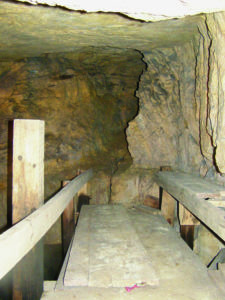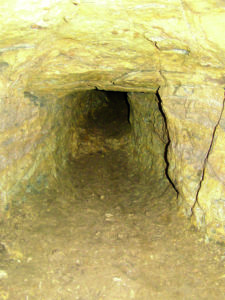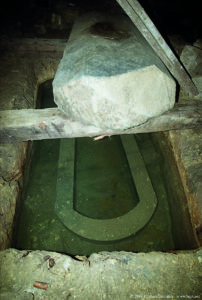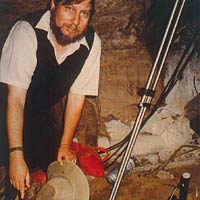The “Osiris” Complex
One of the many mysterious structures found there is located below the causeway leading from the Sphinx and the Valley Temple to the “Chephren” Pyramid. This structure is interesting for two reasons: First, there a large granite trough with a granite cover 30 m / 98.4 ft below the surface, which could not have been, or could only have carried with difficultly through the access shafts, and second, the official Egyptology reveals how it manipulates facts in this case.
The first level can be seen around 4 m / 13.1 ft below through the perpendicular entrance shaft. The next shaft is found in the rear section of the empty rock chamber and is also vertical and leads to the second level around 20 m / 65.6 ft deep. There, an alcove leads to a three vertical shaft down to the so-called Osiris Tomb. The shafts to the three underground levels of the structure have been misaligned, whereby the lowermost chamber has a horizontal passage leading in the direction of the “Cheops” Pyramid, but which grows narrow and impassable after a few meters / feet.
Dr. Zahi Hawass, as a representative of the Egyptian government, is in charge of research at the Giza complex and any official statements regarding them. He has assumed a key role since the 1970s. In an interview with the private researcher, Andrew Bayuk, which Dr. Zahi Hawass published on his website, he plays down the significance of the Osiris Tomb and insists that these underground structures are unimportant, that everyone knows about them, but that many rumors have been spread concerning them.
When discovered in 1935, the lower section of the Osiris Tomb was under water. As the water level dropped as a result of the lowering of the water table connected with the conservation of the Sphinx, all the levels were investigated in 1997 and 1998 (see the scientific discoveries of the Schor team). The second level consists of a central chamber and six alcoves carved from the stone walls. Two of these contain large granite troughs, with Dr. Hawass has called sarcophagi. According to Dr. Hawass, pottery objects and shards were found along with human bones. Based on the style of the pottery objects, he dated the second level to the 26th Dynasty, 500 years before Christ and concluded that the second shaft had been dug at a later date.
However, he offers no evidence that the structure itself is not older than the objects found there. It is also possible that 500 years before Christ, people entered the underground structure, which was built much earlier, to bury their dead. Or perhaps those who broke in died where they were found? It is somewhat astonishing to read that the top Egyptologist insists that the pottery shards found were left behind by those who built the structure, without any consideration of other possibilities (yet echoes other experiences, such as at Vyse and the findings in the “Mykerinos” Pyramid). The logic of the stated chronology is equally astonishing: Since the shafts are not aligned, the third level is reached only through the second, which according to Dr. Zahi Hawass, was built at a later date. Perhaps he was assuming that they were excavated 500 years before Christ in order to bring the two sarcophagi down to their final resting place.
In an interview, Dr. Zahi Hawass emphasized what a “big operation“ it was to remove the debris from the third chamber to the surface 30 m / 98.4 ft above through the vertical shafts after this level, which stood under water for eons, was pumped dry. He never mentions what an enormous enterprise it must have to build this underground structure. The third level is at least 100 cubic meters / 3,530.8 cubic feet in size, estimated using the photos caught in the frame inside the chamber. The chamber is nearly square. There is a rectangular inset to the floor in the middle of the chamber, in which there is a roughly 2.5 m / 8.2 ft long granite trough (Hawass called it: “a large granite sarcophagus”) – officially, the tomb of Osiris.
The trough lies against the back wall of the long inset into the floor and is surrounded by water on the other three sides. The narrow flank on the back wall is very even, while the opposing side is crooked. Rudimentary limestone columns stand at each of the four corners of the stone surrounding, of which not much remains due to erosion from the waters. The counterpart to the trough is a 1.2 m / 3.9 ft wide, 2.5 m / 8.2 ft long and 0.5 m / 1.6 ft high, perfectly cut granite cover, based on the size of which must weigh around 4 tons. The surface is highly polished and bears no inscription. Today this monolithic cover lies on two beams laid across the opening of the inset into the floor. Because neither the trough nor cover is made out of the same stone as the chamber, it remains a mystery just how they were brought to where they were found.
In regard to determination of the age of the structure, Dr. Zahi Hawass stated that Giza was only named “pr osr nb rstw“ in the era of the New Kingdom: “pr” stands for house or residence; “osr” for Osiris; “nb” for master and “rstw” means cemetery or literally, underground tunnel. “Thus, in the New Kingdom, the Giza Plateau was called “House of Osiris, Master of the Underground Tunnel.“ He dated the third level as follows: “Based on the size of the sarcophagus and the style of the pottery that has been found inside the shaft I dated this to 1,550 BC, the New Kingdom…” The evidence he used were the “pr” hieroglyphics found in the Osiris tomb, which led him to conclude that the third level originated in the time of the New Kingdom, because the Giza Plateau was then named “pr osr nb rstw.”
The critical observer, however, simply must ask whether the mere hieroglyphic “pr“ with the Giza symbol automatically correlates to the New Kingdom. Even if this actually was the case, the conclusion that the hieroglyphics found were left there by those who built the structure does not hold water. If the builder wished to make his mark for all eternity with an inscription, then he would have expressed himself more clearly, as did all the other New Kingdom pharaohs. According to Dr. Zahi Hawass, the level was built around 1,550 BC and used as a burial place in the late period, around 550 BC. Even the interviewer, Andrew Bayuk, known as a supporter of the official Egyptologists’ worldview, seemed mystified by this interpretation: “So then you believe this third level to be originally from the New Kingdom and then later used for burial in the Late Period?”
Dr. Zahi Hawass answered this with a simple: “Yes.”
But this begs the question: What was the original purpose of the structure, before it was used as a burial place 1,000 years later? Or was the old mummy removed in the later period to make room for another corpse? Dr. Zahi Hawass’ explanation seems constructed and unbelievable, as his explanations tend to be when he attempts to fit the megalithic structures into the orthodox Egyptologists‘ chronology. In all dynasties, the pharaohs had the burial chambers decorated with color and inscriptions, at least from the floor to the ceiling. However, there are no such decorations in the Osiris structure.
It seems more feasible that this structure was planned and built in entirety many thousands of years ago in an archaic era. The granite troughs in the second and third subterranean floors match the other monolithic structures found throughout Egypt, and like them and the 3 great Giza pyramids, were found empty and without inscriptions. These mysterious structures are evidence of the ability to work with extremely heavy and bulky stone blocks, when in many places; there were much easier construction solutions at hand.
The Osiris Tomb contains yet another anomaly waiting to be explored: The corridor in the direction of the “Cheops” Pyramid narrows to a crack after 3 m / 9.8 ft. In an interview, Dr. Zahi Hawass spoke of plans to send an optical probe through this crack. Without allegedly having further examined the tunnel, the Chief Egyptologist insists that the tunnel does not lead to the Great Pyramid and that this structure originated during the New Kingdom. Furthermore, he points out (accurately) that it reminds him of the Osireion at Abydos (see page 93). According to Dr. Zahi Hawass, the Osiris Tomb of Giza is a copy of the structure at Abydos.
His statements from the year 2000 hint at a sensation: There must be a hollow space behind the crack at the end of the corridor leading in the direction of the “Cheops” Pyramid. Otherwise, there would be no reason to go through the trouble of looking there with a camera. The results of this examination have never reached the public. It is inconceivable that the tunnel exploration project was not continued, particularly since there are active interest groups in Giza who very much want to know more about the masterly structure and the megalithic technology responsible for them.
“Great discoveries will be made in around thirty years around the
pyramids that shall lead to the correct understanding of this complex.“
Prophecy from Dr. J.J. Hurtak in 1973
This is an excerpt from the book GIZA LEGACY.








